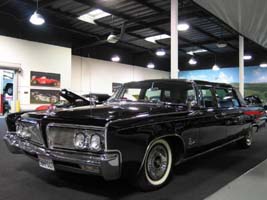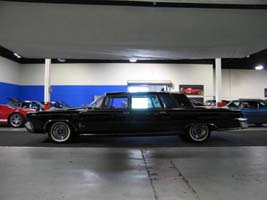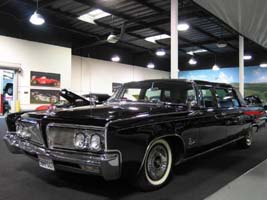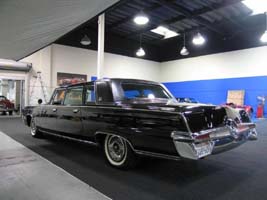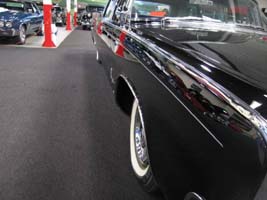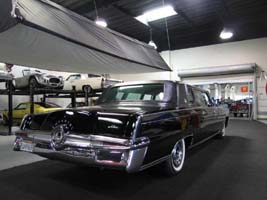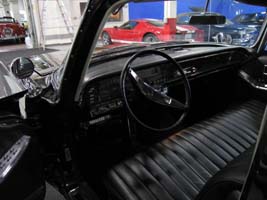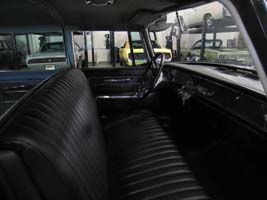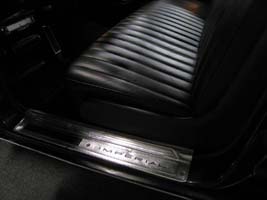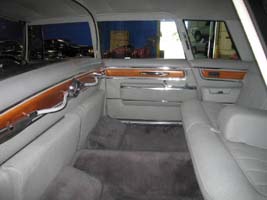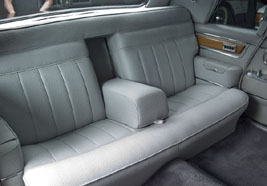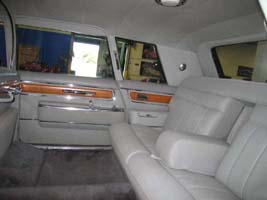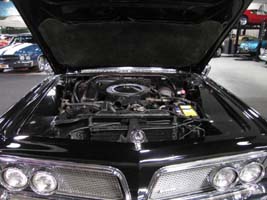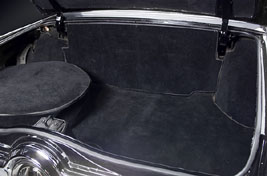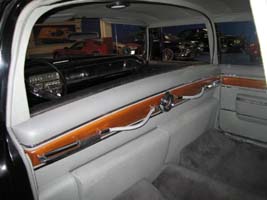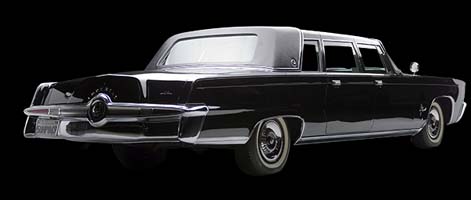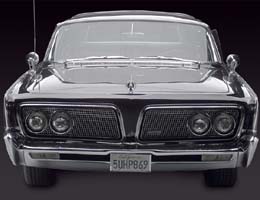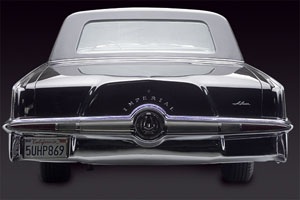
This beautiful Ghia Limousine came up for sale recently. Here's what the owner had to say about it.
This Crown Imperial Ghia Limousine is one of only 10 produced in 1964. The car is the recipient of an older wel maintained restoration. The car drives very well and the 413cid V8 is more than up to the task as well as the pushbutton torque-flite, both of which perform better than one would expect. The original Imperial Owners manual goes with the car.
- 2007 CPW Mopar of Special Merit award winner.
- 1964 Ghia Landau Limousine Article by Chris Hawkins
The 1964 Crown Imperial Landau Limousine by Ghia is one of the last of a line of extraordinary American luxury cars. The Ghia limousines, produced by Chrysler from 1957 to 1965, also represent the last series of coachbuilt cars ever likely to be offered by a major American manufacturer. They were the glorious last hurrah of a tradition of hand craftsmanship that found its zenith in the '30's on all the legendary classics of the era.
The quality of craftsmanship at Ghia, the execution of its coachwork, and the meticulous attention to every detail resulted in a series of Imperial limousines whose grandeur and dignity are unsurpassed in postwar American automobiles. A Crown Imperial Limousine by Ghia is the equal to anything produced by Rollston, Derham, or even Mulliner-Park Ward.
In the postwar era, only the second series Eldorado Broughams, hand hammered by Pininfarina, could come close to the bespoke character of the Ghia Limousine - but never quite match its quality. Although the last of these coach-built Cadillacs was delivered in 1960, a Crown Imperial, custom bodied by Ghia. was still available through your local Chrysler dealer until the 1965 model year. During this period Lincoln had nothing that directly compared with these Italian-bodied customs. Its only special offering, the Lehmann-Peterson Limousine from the mid-'60's, was little more than a crude stretch job in comparison.
Comparing Lincoln and Imperial Limousines
Unlike the L-P Lincoln, the Crown Imperial was bodied as a proper limousine. In this classic configuration one enters the center of the car, is seated in a richly appointed rear compartment, and is thus ensconced in a cocoon of great luxury. This recessed rear seat is typically encircled by a "limousine-style" roof with its small rear window and thick sail panel for privacy and isolation.
In contrast, the twinkle-light festooned, disco-limos of today are little more than tarted up airport hacks. Regardless of how much sheet-metal has been added between the wheels of these vehicles, they aren't real limousines. They are merely stretched sedans. The rear doors still open directly onto the back seat cushion and all passengers must scramble over the rear seat occupants to enter the rear compartment. No proper limousine was ever configured in such an awkward manner.
This car is a real revelation to drive. Vehicles that have been cut completely in half and lengthened nearly 2 feet can be expected to creak and groan and twist a bit. Not this Ghia. The ride is smooth and utterly silent. Despite the car's great length, not the tiniest creak or rattle is to be heard or felt, even over the roughest roads. The body is extremely rigid and exhibits no flexing or vibration - and none of the attendant stress cracking of paint!
All Ghia Limousines were built on the heavy duty X-braced convertible frame, lengthened 20 1/2 inches behind the center point. Additional strength came from the addition of massive boxed frame rails that are up to 8" wide(!) along the full length of the rocker panels. Needless to say, these cars are incredibly solid. One note: as a testament to the high caliber of workmanship at Ghia, one has to look carefully to see where the frame was stretched. Even these out-of-sight welds have been neatly finished off.
From the cowl rearward, almost everything is familiar yet completely different from regular production models. Everywhere you look you discover a different custom modification by Ghia vs. the stock Imperial. For instance, close inspection of even familiar-looking items like the 1964 interior door handles reveals that they, too, have been modified. In front, the interior handles are wrapped in black leather, and in the rear the handles have walnut wood-grain inserts.
Other extravagant custom touches abound. These features are fairly consistent in all 1957 to 1965 Ghias. They include:
- Seat frames, both front & rear, are custom made by Ghia and are unique to these limousines.
- The front seat is several inches wider than stock, stretching from door sill to door sill. There is a slightly coved depression in the driver's backrest for extra room. Because of its width, the upper seat cushion also has slight notches on its sides to clear the door armrests. The thick black leather upholstery is carefully pleated in such a way that no stitching shows. The front seat is non-adjustable, but unless one is 6'7", one can usually adapt!
- The front door panels are upholstered in a solid sheet of black leather, with LeBaron-style chrome trim pieces. Even the flip-up armrest pads are leather covered. The kick-panels and wind-lacing are faced in black leather, also.
- All the hardware and delicate metal trim in the rear compartment is custom cast and richly chrome plated.
- The wood paneling in the rear compartment is solid walnut, up to 1/2" thick.
- The double-hinged chromed framework of the jump-seats is a work of art.
- The headliner and visors are covered in broadcloth, with matching leather edging on the visors.
- The upholstery in the rear compartment is the softest, thickest broadcloth imaginable. The two crowns embroidered in silk on the rear seatbacks are subtle perfection. This is the only place where thread is visible. All other seams are constructed so that no stitching shows. The workmanship and quality of materials is so extraordinary that replacement would pose an almost insurmountable restoration challenge.
- The leather trim and mouton carpeting in the rear compartment are both dyed to exactly match the color of the broadcloth. The result is a rich, monochromatic array of luxurious textures.
- The auxiliary rear carpeted floor mats have concealed leather snaps to hold them in place over the sheared mouton. These mats are completely bound in leather.
- A concealed panel in the right rear armrest has remote controls for the radio. The concealed panel in the left rear armrest has controls for the rear heat and air conditioning. The heater is a custom, underseat set-up that blows through two chrome grilles at the base of the armrests. The A/C is a standard, trunk-mounted evaporator unit with stock vents on the package shelf. Earlier Ghias, with their gentler roof curvature, ducted the A/C to custom roof-mounted outlets.
- A four-button chrome window switch is mounted on each side panel of the rear compartment. It operates left & right door windows, the division window, and the overhead lighting - a custom Ghia ceiling fixture. There is also a power door lock switch on all four door panels in 1964 & 1965.
- The rear doors are key lockable from the outside, but use a different key than the front doors. (This traditional limousine security feature - used to thwart pilfering chauffeurs - is rendered obsolete by the power door locks. Apparently old traditions died hard at Ghia!)
- The trunk is fully lined in a Wilton-style dense, low pile carpet. A carpeted panel spans the wheelwells concealing the rear A/C plumbing and the remote-controlled radio assembly. Even the trunk lid is lined with a bound carpet panel and the lid is counterbalanced to raise just 3 inches when the remote release is activated. The release button is mounted on the lower dash above the hood release handle so the chauffeur did not have to fumble in the glove-box every time he opened the trunk.
- There are dual courtesy lights in the trunk and dual courtesy lights in the engine compartment. The door sills and door edges have had all seams & joints filled and finished. The latching hardware is all chrome plated. There are no drip rails on the roof or on the doors. Carefully engineered, concealed channels and drainage tubes handle water flow.
As befits the custom nature of these cars, don't be surprised when you see a Ghia limousine that exhibits bits and pieces from previous or subsequent models years. For instance, most '57 Ghias had '58 grills, 1959 Ghias still had Hemis, 1961 Ghias used 1960 bodies, and 1965 models still had pushbutton Torqueflite.
If you ever have the opportunity to closely inspect a Ghia Limousine you will have a very rewarding experience. Parked next to these full classics it is obvious the Ghia Limousine is the equal of any of them for exclusivity, rarity, and quality of coachwork - and it absolutely rivals any of them in sheer star power! As fine as our regular production Imperials most certainly are, Ghia coachwork takes the Incomparable Imperial into an elevated realm of magnificence.
If you're the new owner, write in and tell us more about this beauty!
|


